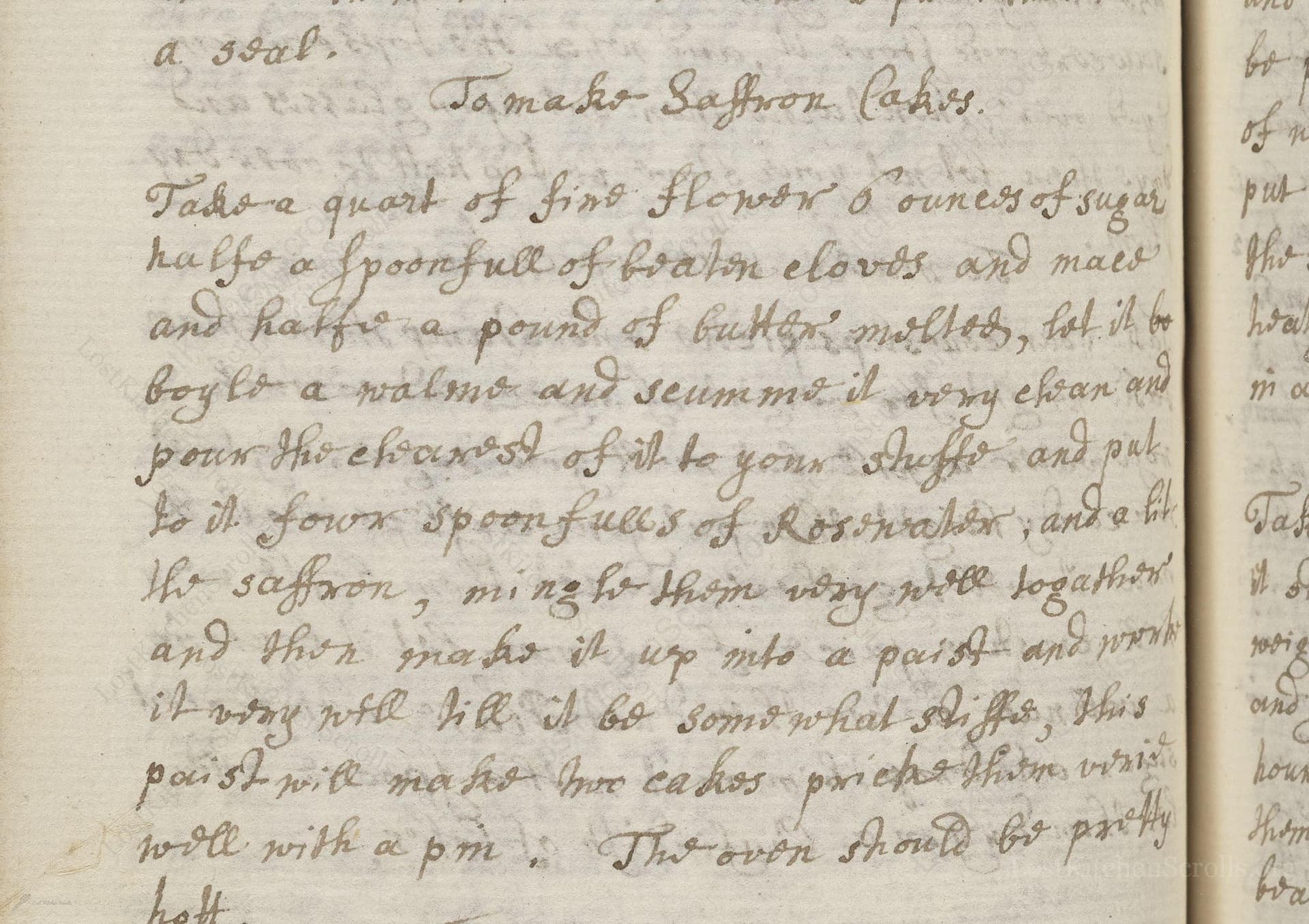To Make Saffron Cakes
From the treasured pages of Manuscript cookery book
Unknown Author

To Make Saffron Cakes
"Take a quart of fine flower, 8 ounces of sugar, halfe a spoonfull of beaten cloves and mace and halfe a pound of butterr, melted, let it be boyle a walme and scumme it very clean and pour the clearest of it to your stuffe, and put to it your spoonfulls of Rosewater, and a little saffron, mingle them very well together and then make it up into a paist and work it very well till it be some what stiffe. This will make two cakes. pricke them well with a pin. The oven should be pretty hott."
Note on the Original Text
This recipe uses the straightforward yet elliptical prose common in seventeenth-century English cookery manuscripts. Spelling varies—'flower' for flour, 'paist' for paste (dough), and 'scumme' for scum—as the standardized spellings we know today were not in use. Quantities are sometimes vague or implied, and instructions presume a certain degree of kitchen knowledge. Notably, 'boyle a walme' means to heat the butter to just below boiling, and 'pricke them well' refers to the small holes we still make in pastry to prevent bubbles. The method is an early example of a rustic, enriched cake made aromatic with saffron and rosewater, baked by eye and experience rather than precise temperature and time.

Title
Manuscript cookery book (1680)
You can also click the book image above to peruse the original tome
Writer
Unknown
Era
1680
Publisher
Unknown
Background
A tantalizing window into the kitchens of yesteryear, this late-17th century collection presents recipes and culinary wisdom meant to delight and surprise even the most discerning of historical gourmands.
Kindly made available by
Folger Shakespeare Library
This enchanting saffron cake recipe hails from an English manuscript dated roughly between 1675 and 1686, a time when showy ingredients like saffron and rosewater were the hallmark of celebratory baking. Saffron, then as now, was a luxury spice—its golden hue a sign of festivity, often reserved for special occasions. Seventeenth-century England was seeing the rise of sugar in home kitchens, and the inclusion of delicate spices and aromatics shows the worldly influences at work during this era. Such cakes could mark births, weddings, or great feasts in well-off homes.

Historically, this dough would have been mixed in large wooden bowls, with hands or sturdy wooden spoons. The butter would be melted in an iron pan over an open fire, then clarified by skimming off foam from the top. After kneading, the cakes were shaped by hand and pricked with a simple pin or skewer, which allowed steam to escape for an even bake. The cakes would be baked directly on the stone floor of a wood-fired oven, or on metal baking sheets if available, at a 'pretty hott' heat—what we would now call a fairly hot or moderate-to-hot oven.
Prep Time
30 mins
Cook Time
25 mins
Servings
16
We've done our best to adapt this historical recipe for modern kitchens, but some details may still need refinement. We warmly welcome feedback from fellow cooks and culinary historians — your insights support the entire community!
Ingredients
- 2.2 lbs plain white flour
- 8 oz caster sugar
- 8 oz unsalted butter (clarified if possible)
- 1/2 tsp ground cloves
- 1/2 tsp ground mace
- 1 tbsp rosewater
- 0.004 oz saffron threads (substitute: 1/8 tsp ground turmeric for color, if necessary)
Instructions
- To make Saffron Cakes with today's kitchen in mind, begin by measuring out 4 1/2 cups (about 2.2 lbs) of plain white flour.
- Cream together 8 oz of caster sugar with 8 oz of good-quality unsalted butter, first melting the butter gently and skimming off any froth to use only the clear part—this mirrors the historical clarification process.
- Stir in about half a teaspoon each of ground cloves and ground mace, a generous tablespoon (about 1 tbsp) of rosewater, and a small pinch (about 0.004 oz) of saffron threads dissolved in a little warm water to release their color and aroma.
- Combine all ingredients to form a stiff yet pliable dough, kneading well.
- Divide the dough in two, shape each half into rounds or flats, place on a prepared baking tray, and prick the surfaces decoratively with a fork or skewer.
- Bake in a preheated oven at around 350°F until golden and baked through, roughly 20–25 minutes but watch closely.
Estimated Calories
210 per serving
Cooking Estimates
You will spend about 20–30 minutes getting ingredients ready and making the dough. Baking takes about 20–25 minutes. One batch makes about 16 slices, each around 210 calories.
As noted above, we have made our best effort to translate and adapt this historical recipe for modern kitchens, taking into account ingredients nowadays, cooking techniques, measurements, and so on. However, historical recipes often contain assumptions that require interpretation.
We'd love for anyone to help improve these adaptations. Community contributions are highly welcome. If you have suggestions, corrections, or cooking tips based on your experience with this recipe, please share them below.
Join the Discussion
Rate This Recipe

Den Bockfisch In Einer Fleisch Suppen Zu Kochen
This recipe hails from a German manuscript cookbook compiled in 1696, a time whe...

Die Grieß Nudlen Zumachen
This recipe comes from a rather mysterious manuscript cookbook, penned anonymous...

Ein Boudain
This recipe comes from an anonymous German-language manuscript cookbook from 169...

Ein Gesaltzen Citroni
This recipe, dating from 1696, comes from an extensive anonymous German cookbook...
Browse our complete collection of time-honored recipes



